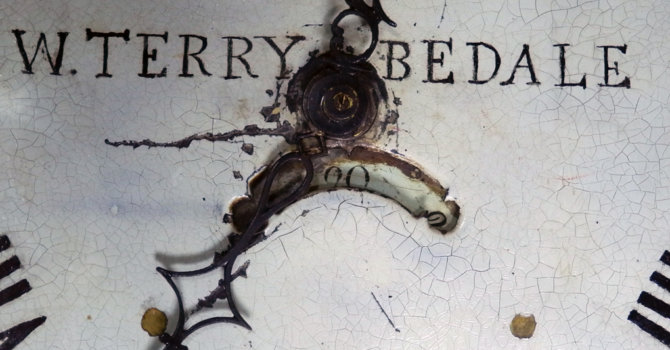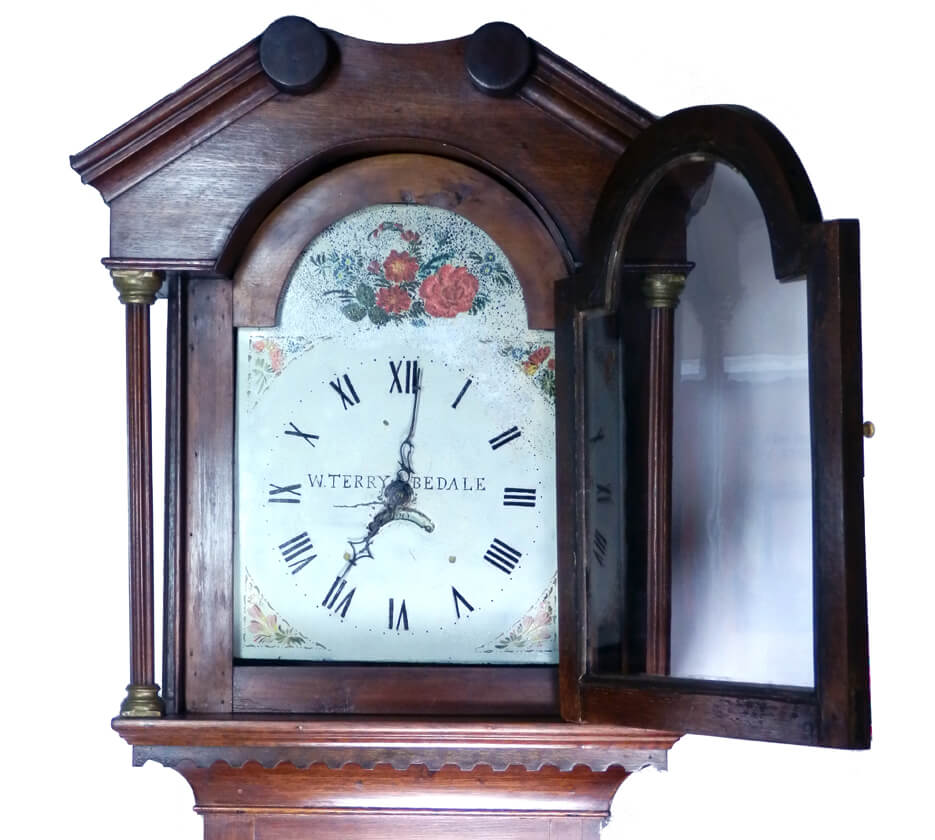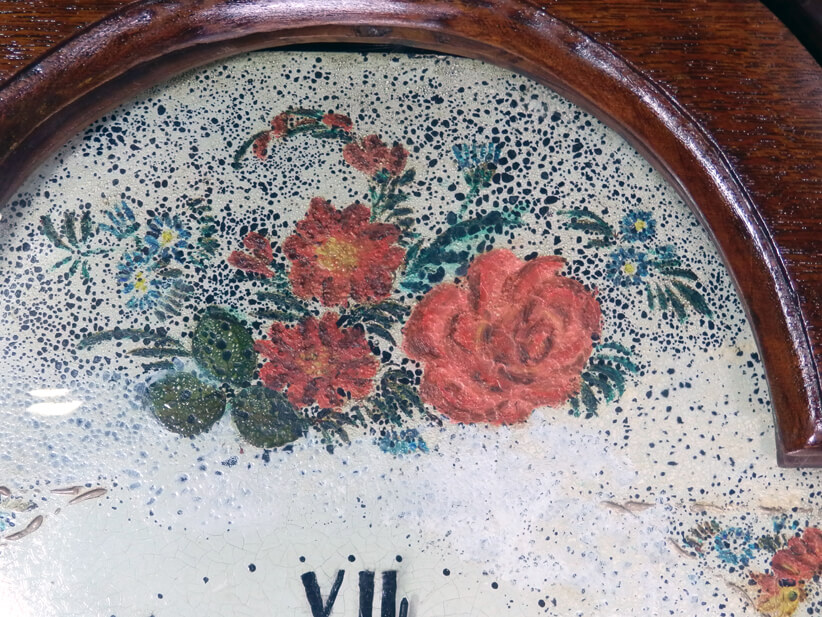Sometimes it is extraordinary how small serendipitous consequences can have great results. Such was the outcome from a recent visitor to the Museum who came from Bedale, a tiny village in the Yorkshire Dales. They reported back to their local newspaper that they had seen a longcase clock in the Abbey Museum in Australia that came from Bedale, made by the famous clock maker, William Terry. The newspaper item was spotted by a Mr David Severs, who had published a book on the Clockmakers of Bedale. David then contacted the Museum and generously offered to date the Abbey Museum’s clock and provide information on its maker, William Terry.

The vast majority of painted-dial clocks, or white-dial clocks as they were known at the time, were made in Birmingham and the manufacturers copied each other’s styles. From their introduction about 1772 until around 1800 painted-dial clocks had Roman hours and dotted minutes marked 5,10,15… with either gold decoration in imitation of the cast brass spandrels on brass-dial clocks or flowers or fruit in the corners often in raised gold triangles. From about 1800 until about 1825/30 they had Arabic hours and minutes marked 15,30,45,60 often against a single track and they often had ‘geometric’ designs in the corners. After about 1825/30 they reverted to Roman hours and they had a double minute band with no numerals. These later clocks had lots more paint and matching sets of fours in the corners such as the seasons, the continents, etc. This information dates our clock to before 1800 but the dial has been repainted at some stage.

More than a Clockmaker
William Terry turned out to be much more than a clockmaker and we can track his life through various documents that have survived. I have happily plagiarised much of David’s account of William he sent us. He was born in the Dale village of Thoralby near Aysgarth (from where the Abbey Museum has a large collection of legal documents) in 1749. His father is listed as a watchmaker and it seems young William did his apprenticeship with his father before launching out on his own at Bedale. He married a widow, Elizabeth, in May 1773 and they would have seven children. When William’s occupation was recorded in the registers it was always entered as ‘watchmaker’ but whoever prepared the transcript of the register for the county record office transcribed the occupation in the burial entry for baby Marmaduke in 1778 as ‘matchmaker’! According to his biographer Robert Hird, William was ‘of the middle size, robust, and powerful in his person, of rather fair complexion. He was ‘a strong athletic man, his gait in walking was much admired. One day, he walked from Bedale to Mr Swann’s Bank in York, transacted his business, and returned, which was a distance of sixty eight miles’. William was in business at Bedale forty-nine years.
There are accounts of him working on the Bedale Church clock – an expensive business. In April 1797 the rector and four and twenty resolved ‘that the churchwardens may contract with Mr Terry the Watchmaker for putting the Chimes as to proper Order and repair and upholding them in that Condition for the space of the years so that they shall go as well as when first set for any sum not exceeding five guineas to be paid at the year end from the time of his completing the same’. From 1801 he was being paid £1 15s. 0d annually to repair and wind the clock but he was also paid extra for parts such as the ‘New Pulley for the preservation of Chimes Rope’ and this arrangement continued for some years. In 1811 William repaired ‘Damage done by Lightening to the Dial Work and Wyres of the Clock’ for which he charged twenty-five shillings.
However, William Terry was better known in Dale history for his astonishing religious conversion. We are told in his biography that he was a ‘great cock-fighter, horse-racer, card-player’ but gambling was not one of his vices and he was ‘not totally bad … in everything: he was no drunkard, he was no scorner … and he was affectionately attached to his family and took care to provide for those of his house’.

In the early records of Bedale Baptist church it is said that in 1785 William was called from the vices of the world in his 35th year’. Friends told his biographer that the leading circumstance in his conversion was the sudden death of his friend William Pratt of Askrigg with whom he had attended all the principal races in Yorkshire and Lancashire. An itinerant Wesleyan Methodist preacher called Gill, who had been warned not to preach at Bedale market cross because he would probably be injured by William and his party, sought William’s help to avoid being molested. William agreed to stand next to him when he preached and from that time he was a changed character. He gave up cock-fighting and started family prayers instead. He became a regular church-goer to Baptist and Wesleyan missions outside of the strictures of the Anglican Church.
His non-conformist religious beliefs got him into trouble with law. The Bedale manorial jury list for 1786 has an endorsement at the bottom which reads
Whereas Wm Terry and Jos Todd by begotted principles have refused to stand upon the Jury it is ordered by this court to mulch them in heavy penaltys to bring them to right Reason.
Somehow William managed to find time to fit his religious pursuits in with his clock making. Church records give his routine and this shows that, in addition to his ‘devotions’ at 6am, 10am, 2pm and 7pm each Sunday, he went to Masham, Carthorpe or Northallerton each Wednesday evening; he taught at home each Thursday evening; and once a month on Fridays he prepared new members. He conducted his first wedding at the chapel in December, 1816. When he was seventy, William preached at Richmond on 11 July 1819. It rained heavily, he was drenched, preached in wet clothes and caught a cold. It was his last sermon. At his funeral so many people attended the sermon had to be preached in the churchyard. After his father died William’s son swore to the church authorities that his father’s estate did not amount to more than £200.
So thanks to an unexpected visitor we have been able to date our clock and bring a long-forgotten clockmaker out of the darkness of the past and know something of his life.

